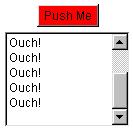
You're writing a program with a graphical user interface. You want the user to click a button to change the state of the program or cause some action to occur.
When the button is pushed, the word "Ouch!" is added to the text area.
This example is demonstrated by the following applet, although the code below would
be suitable for use as a special panel in an application's GUI.
Note: The application would need
to declare a JFrame and main method elsewhere. See
Graphical Application for an example using JFrame
 |
|
| Applet | Image of the JPanel |
package Patterns.Button;
import javax.swing.JPanel;
import javax.swing.JButton;
import java.awt.Color;
import javax.swing.JTextArea;
import java.awt.event.ActionListener;
import java.awt.event.ActionEvent;
public class ButtonEx extends JPanel
{ // Instantiate a button and a textarea.
private JButton pushMe = new JButton();
private JTextArea ta = new JTextArea("", 5, 15, TextArea.SCROLLBARS_VERTICAL_ONLY);
public ButtonEx()
{ // Set the attributes for the buttons
pushMe.setBackground(Color.red);
pushMe.setLabel("Push Me");
pushMe.addActionListener(new ButtonListener());
// Add all the widgets to the applet
this.getContentPane().add(pushMe);
this.getContentPane().add(ta);
}
// The listener for the button.
private class ButtonListener implements ActionListener
{ public void actionPerformed(ActionEvent evt)
{ if (ta.getText().length() > 0)
{ ta.append("\n"); }
ta.append("Ouch!");
}
}
}
package <name-of-package>;
import javax.swing.JPanel;
import javax.swing.JButton;
import java.awt.event.ActionListener;
import java.awt.event.ActionEvent;
public class <name-of-class> extends JPanel
{ private JButton <name-of-button> = new JButton("<label>");
public <name-of-class>()
{ <name-of-button>.addActionListener(
new <name-of-actionlistenerclass>());
this.getContentPane().add(<name-of-button>);
}
private class <name-of-actionlistenerclass> implements ActionListener
{ public void actionPerformed(ActionEvent evt)
{ <code-to-do-when-button-is-clicked>
}
}
}